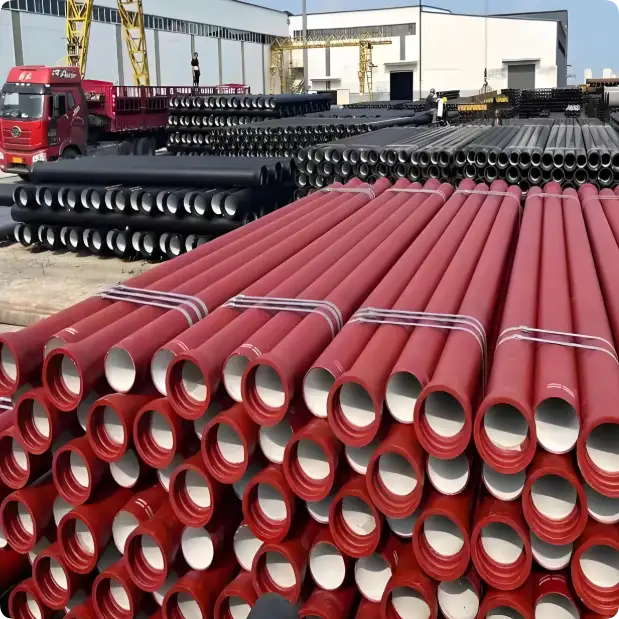Ductile iron pipe (DIP) is a critical material for water and wastewater systems worldwide, valued for its strength, durability, and corrosion resistance. Understanding its specifications ensures optimal performance in infrastructure projects. This guide covers key technical parameters, international standards, and practical considerations for selecting ductile iron pipes.

1. Key Specifications of Ductile Iron Pipes
1.1 Material Composition
-
Base Material: Ductile iron (also called nodular cast iron) contains 3.2–3.6% carbon, 2.2–2.8% silicon, and trace amounts of magnesium for enhanced ductility.
-
Tensile Strength: ≥ 420 MPa (60,900 psi)
-
Yield Strength: ≥ 300 MPa (43,500 psi)
-
Elongation: ≥ 10% (ensures flexibility under pressure).
1.2 Dimensions and Weight
-
Diameter Range: 80 mm (3 inches) to 2,600 mm (102 inches).
-
Wall Thickness: Classified by “pressure classes” (e.g., Class 150, Class 350) or “thickness classes” (e.g., K7, K9).
-
Length: Standard pipes are 6 meters (19.7 ft); custom lengths available.
-
Weight: Varies by diameter and thickness (e.g., a 6-meter DN300 pipe weighs ~320 kg).
1.3 Pressure Ratings
-
Working Pressure: Ranges from 16 bar (232 psi) to 64 bar (928 psi), depending on class.
-
Surge Pressure: Designed to withstand 2.5× working pressure temporarily.
2. International Standards for Ductile Iron Pipes
DIP specifications align with globally recognized standards to ensure compatibility and safety:
| Standard | Region | Key Requirements |
|---|---|---|
| ISO 2531 | Global | Dimensions, pressure classes, coatings. |
| EN 545/EN 598 | Europe | Water/wastewater applications, material grades. |
| AWWA C151/C150 | North America | Design, manufacturing, and installation. |
| AS/NZS 2280 | Australia/NZ | Ductility, hydrostatic testing. |
3. Protective Coatings and Linings
To extend service life (often exceeding 100 years), DIP uses advanced coatings:
3.1 External Coatings
-
Zinc + Bitumen: Standard for corrosion resistance.
-
Polyurethane (PU): For aggressive soils or marine environments.
-
Epoxy: High chemical resistance.
3.2 Internal Linings
-
Cement Mortar Lining (CML): Prevents scaling and maintains water quality.
-
Polyethylene (PE) Sleeve: For wastewater pipelines.
4. Applications by Industry
-
Water Supply: High-pressure mains, municipal distribution.
-
Sewage Systems: Resists hydrogen sulfide corrosion.
-
Mining: Handles abrasive slurries.
-
Industrial: Cooling water, fire protection systems.
5. Installation and Maintenance Guidelines
-
Joint Types: Push-on joints (TYTON), flanged joints, mechanical joints.
-
Bedding: Use granular materials to avoid point loading.
-
Testing: Hydrostatic pressure tests mandatory post-installation.
6. How to Choose the Right Ductile Iron Pipe
Consider these factors:
-
Fluid Type: Water, sewage, or chemicals.
-
Soil Conditions: Corrosivity, moisture levels.
-
Pressure Requirements: Match class to system demands.
-
Local Standards: Compliance with regional codes (e.g., AWWA vs. EN).
7. FAQs About Ductile Iron Pipe Specifications
Q1: How does ductile iron differ from cast iron?
A: Ductile iron has higher tensile strength and flexibility due to its nodular graphite structure.
Q2: Can DIP withstand seismic activity?
A: Yes—its elongation properties make it resistant to ground movement.
Q3: What is the lifespan of a ductile iron pipe?
A: Properly coated DIP lasts 100+ years with minimal maintenance.
Ductile iron pipe specifications balance strength, adaptability, and longevity, making them ideal for global infrastructure. By aligning with ISO, AWWA, or EN standards and selecting appropriate coatings, engineers ensure reliable performance across diverse applications. For project-specific guidance, consult manufacturers or refer to regional codes.
References:
- ISO 2531: Ductile Iron Pipes, Fittings, Accessories and Their Joints for Water Applications – International Organization for Standardization
- EN 545: Ductile Iron Pipes, Fittings, and Accessories for Water Applications – CEN European Committee for Standardization
- ANSI/AWWA C150/A21.50: Thickness Design of Ductile Iron Pipe – American Water Works Association
- AS/NZS 2280: Ductile Iron Pipes, Fittings and Accessories – Standards Australia / Standards New Zealand
- Ductile Iron – Wikipedia

